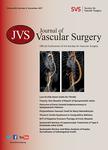版权所有:内蒙古大学图书馆 技术提供:维普资讯• 智图
内蒙古自治区呼和浩特市赛罕区大学西街235号 邮编: 010021

作者机构:Univ Washington Div Vasc Surg 1959 NE Pacific StBox 358811 Seattle WA 98195 USA Texas A&M Coll Med MD PhD Program College Stn TX USA Pacific Northwest Univ Hlth Sci Coll Osteopath Med Yakima WA USA
出 版 物:《JOURNAL OF VASCULAR SURGERY》
年 卷 期:2025年第81卷第5期
页 面:1074-1082页
核心收录:
学科分类:1002[医学-临床医学] 100210[医学-外科学(含:普外、骨外、泌尿外、胸心外、神外、整形、烧伤、野战外)] 10[医学]
主 题:Endovascular aneurysm repair Imaging surveillance Loss to follow-up Open surgical repair Ruptured abdominal aortic aneurysm
摘 要:Objective: Post-repair surveillance of ruptured abdominal aortic aneurysm (rAAA) is critical for detecting potential complications. Substantial loss to follow-up has been reported in populations undergoing elective endovascular aortic repair (EVAR);however, there is limited data on follow-up rate among patients presenting with rupture. Thus, we investigated follow-up trends and factors influencing retention at a major academic referral center with a wide service area. Methods: We included patients with rAAAs from 2002 through 2023 in this retrospective study. Loss to follow-up was defined as absence of vascular surgeon evaluation for 2 years (EVAR) or 5 years (open repair) prior to death or present day. Multivariate regression and survival models assessed the influence of potential factors on follow-up and survival outcomes. Results: Of 455 patients who presented with rAAAs, 60% who underwent EVAR and 39% who underwent open repair were lost to follow-up. Twenty percent of patients who underwent EVAR were lost after initial admission, and 40% of patients were lost after the 1-month postoperative follow-up visit. There were no significant differences in baseline demographics. Patients lost to follow-up less commonly had stage 4 chronic kidney disease (7.2% vs 24.3%;P = .02) and prior EVAR (10.0% vs 29.2%;P = .01) at time of rupture. Secondary interventions were less common in patients lost to follow-up (14.5% vs 39.0%;P = .01). In multivariate analysis of patients who underwent an EVAR, residing more than 10 miles from hospital was associated with loss to follow-up (odds ratio [OR], 4.93;95% confidence interval [CI], 1.14-21.29). Prior endograft at time of rupture (OR, 0.24;95% CI, 0.06-0.89), and estimated glomular filtration rate 30 mL/min/1.73m(2) (OR, 0.23;95% CI, 0.06-0.93) were associated with complete follow-up in patients who underwent EVAR. Patients who were lost to follow-up trended towards worse survival (hazard ratio, 2.04;95% CI, 0.67-6.26), whereas prio